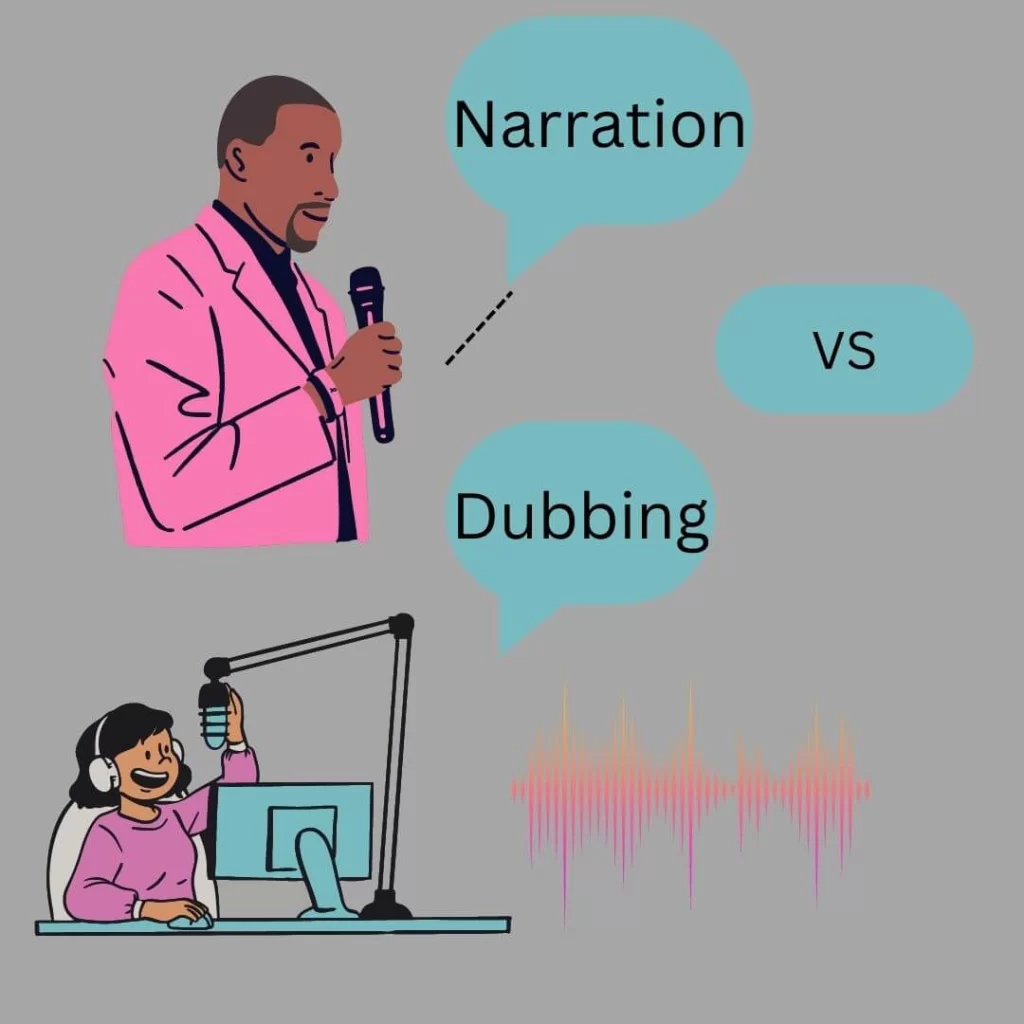Due to the increasing demand for localization, we can see an uptrend in voiceover and dubbing services. Sometimes it is confusing to differentiate between voice-over and dubbing, as the objectives of both techniques are too similar in many cases.
For example, there is a movie called “Life of Pie” with original audio in English. The movie dialogue is dubbed into Hindi by lip-synching actors on screen, and voice actors narrate the story in both English and Hindi in between the movie scenes with voice-over techniques.
In this article, you are going to learn about the types, and methodologies used for both formats. Also, we are going to see the pros and cons of each format depending on the target language, tone, and emotions needed to deliver and use the case. Though both techniques are used for audio translation, the required area of expertise and final impact are completely different.
What is a voice-over?
Voice-over is a method of creating sound from outside to narrate or explain information, where we can hear the sound but not see the voice actor. It is an exclusive feature where voice is added externally to an existing or ongoing situation. It may be read by a voice-over artist or actor in theatre, filmmaking, television, radio, etc.
Voice-over is widely used in movie trailers to promote the film or to attract the audience through sound. Voice-over is an off-camera action in which someone reads the script. The voice-over artist or actor on the screen should be in synchronization with the current activities for a proper explanation of the scenes.
There are two kinds of voice-over: narration, which tells a story about what’s happening on screen, and non-narrative, which is for educational or informational purposes with good voice clarity and clear pronunciation.
What is dubbing?
Dubbing is(re-recording or mixing) a post-production process done after production. Dubbing is a process used in filmmaking or video productions. In dubbing, additional recordings are mixed and lip-synced with the original audio to create a new or finished track.
Dubbing can be referred to as the replacement of a voice to make films or other content in different languages. Dubbing replaces the previous voice in another language. Dubbing is more efficient for additional dialogue replacement, in which the dubbing artist record in synchronization with the original audio with correct lip movements.
Dubbing is the process of adding a new voice, new dialogue, or a new soundtrack to an already completed or filmed project completely replacing the original language. Dubbing is mainly a language replacement process.
Did you know dubbing industry is expected to reach a valuation of US $189.80 million by 2030 at a CAGR OF 5.69% over the forecast period 2022-2030.
People’s increasing requests or demands for foreign-language films and web series to be watched in their language for better understanding have resulted in the widespread use of dubbing.
The original project is dubbed into another language considering lip movements, language, emotions and tones, scripts.
Kinds of dubbing:
There are two kinds of dubbing: animation dubbing, in which the voice artist has more control over his performance because animation has different nuance than human faces or a human voice, and human voice dubbing. The second type is live-action dubbing, which involves the original performer acting in a different voice.
Voice-over vs. dubbing: What are the key differences?
1) In terms of creativity, dubbing has more creative abilities to attract an audience, whereas voice-over strictly adheres to the original content.
2) Both voice-over and dubbing are methods of explaining stories or messages to an audience. However, the voice-over is nothing but narration with less emotion and tone quality than the original audio. While dubbing is more accurate because it retains the original’s full range of emotions, tonality, and technical richness.
3) Voice-over is like a storyteller, while dubbing is like translating from one language to another; while translating the audio, it hides evidence of translation as it comes across as pure native-language content for the target audience.
4) Although dubbing should be more accurate to the original script, voice-over does not have to be perfect.
5) Voice-over is a production technique in which an external voice is added to films, television, or radio. A voice-over artist does not appear on a screen; he works behind the scenes. Whereas dubbing is much more active because it is a language substitute or replacement, where dubbing artists have to lip sync with on-stage actors.
6) Dubbing is a language translation or replacement technique in which the original voice is replaced with a new voice during the recording process. While recording, one should be careful to maintain the same lip-sync, emotions, and tone as the original speaker.
Dubbing vs. voice-over: Which one should I choose?
When exploring the realm of audio-visual production, the distinction between voice-over services and video dubbing services plays a crucial role, delineating two distinct methodologies for enhancing content. Voice-over services involve adding a supplementary narration or commentary to a video, enriching the viewer’s experience with additional information or context.
This approach is commonly employed in documentaries, educational videos, and advertisements, where the original audio track remains intact. Conversely, video dubbing services entail replacing the original audio track of a video with a translated or alternate language track, ensuring seamless integration of dialogue or narration for a target audience.
There is an increasing demand from the audience to explore worldwide films, so dubbing is more demanding to deal with language problems but it is more time-consuming than voice-over. Voice-over can be used to tell a story or translate information. But the primary objective of dubbing is to withhold the information of original speaker.
Voice-over is suitable for informational content like training or e-learning videos and documentaries. While dubbing is best for films, TV shows, and content-oriented web series to convey ideas to illiterate audiences, Off-camera voiceover is well-known for instilling trust in the presented video, so it is cost-effective.
Voice-replacement dubbing is more cost-effective than full lip-synched dubbing because it engages the audience. It gives a visual experience, but translation, it requires the best casting and lip-synching, which need technical equipment, so it is expensive.
Want to know which one to choose? Reach our strategic managers to know inputs on which format suits your needs.





